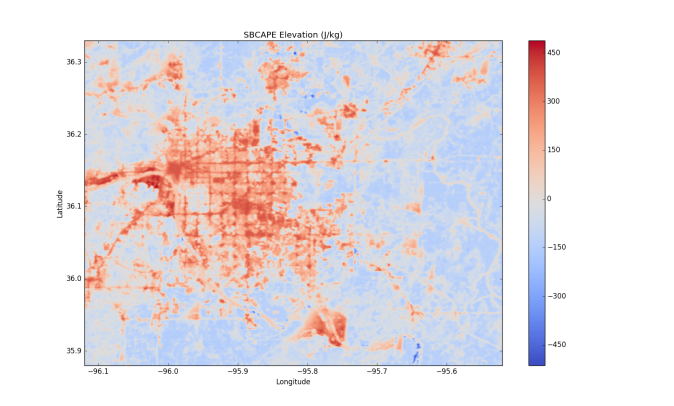For the past week, I have been in snowy Stowe, Vermont, where the leading experts on severe storms gathered around fireplaces to discuss recent research in the field. Before you ask: yes, a group of meteorologists planned a conference for one of the only places in the lower 48 states where it’s already winter, and the general mood was oddly jovial when it snowed on Sunday, Wednesday, and Thursday (with cold rain in between). My main purpose for attending was to present a poster on my heat island mapping algorithm and its potential usefulness in helping to predict tornadoes. But by the end of the week, I realized my own poster presentation was a drop in the bucket compared to the many new colleagues I met and gained valuable insights from, as typically happens at gatherings of brilliant and accomplished scientists.
My poster, titled “A Simple Boundary Layer Parameterization of Heterogeneous Land Surfaces Applied to Convective Updraft Prediction,” was generally well-received, partly due to its ambiguous title. By not mentioning tornado prediction explicitly, I avoided some controversy and instead attracted attendees who were specifically interested in terrain interactions and surface layer modeling. This way, I received mostly positive feedback and a few very good suggestions on how to improve my experimental methods. Perhaps more importantly, I was able to plant the seed that certain upwind features can greatly increase the probability for a tornado, displaying tornado tracks overlaid upon heat island simulations derived from realistic weather conditions. At least two professors who have the abilities and resources to take this research to the next level were very interested in my work, which is great news for the future of this project! Overall, I am relieved that the poster was met primarily with either strong interest or at least open-minded curiosity – gives me some validation for my efforts over the past 2+ years. A link to my poster can be found here:
After my poster session on Monday, I spent the next 4 days attending talks and approaching other professors, research professionals, and students with similar research interests. I am still sifting through pages of notes from the sessions, but I feel like I should highlight a few key points from the week. First, the mechanism for tornadogenesis is still up for debate, but just in the last two years we appear to have made huge strides toward a full understanding. Assisted by the supercomputer simulations and cloud visualization graphics from Leigh Orf’s group, a feature called the streamwise vorticity current (SVC), which forms where the warm inflow sector meets the cold pool in the forward flank region of a rotating supercell, is the primary suspect implicated in collecting, advecting, tilting, and stretching small-scale circulations into a strong column of rapid rotation. The radar signature of an SVC, heretofore an elusive and primarily theoretical feature of these storms, was pointed out by multiple talks and posters. NC State postdoc Brice Coffer expounded on another interesting observation that the inflow velocity field is most often perpendicular to where an SVC would occur (rather than directed at the main updraft location). Together, these studies point to a mechanism wherein the inflow gains vorticity from interacting with the cold pool then gets advected into the storm’s “giant vacuum cleaner” updraft where the tornado is observed. While this doesn’t get to the heart of how or why a tornado becomes so intense at the ground level, it sure feels like we’re getting warmer, even compared to just two years ago.
Tornadoes aren’t the only aspect of severe thunderstorms that require further research: I was surprised to learn that hail prediction is perhaps even less certain, a common refrain among hail experts. The advent of dual-polarization radar can better estimate hail size, sure, but this also opened a Pandora’s box of other questions about how large hail cores form and how to avoid misleading dual-pol echoes. Likewise, lightning was hardly discussed at this conference, even though it wreaks significant damage in severe storms. Despite these gaps, the performance of mesoscale models like WRF, HRRR, and WoF in predicting exact supercell locations before they develop is very promising, as the lead time for severe thunderstorm warnings has improved drastically over the past decade.
A cool aspect of meteorology conferences is that you also get to meet operational meteorologists, whose forecasts are an active testbed for models developed by researchers and academics. Unfortunately, many of the datasets assembled by the operations community are left largely untouched by the academic community, who often lean heavily on event-specific data collected with in-house equipment during limited-scope field campaigns. I became friends with Bryan Smith from the Storm Prediction Center, who has compiled massive archives of radar and synoptic data for forecast assessment. It’s a wealth of knowledge that he wants to make available for everyone, but he came to the hard realization that most researchers in the field will return to insularity as soon as the conference ends. In order for my research to reach a successful endpoint, I know I will have to buck that trend. I hope to keep this new network of meteorology connections open, because deciphering that link between terrain and tornadogenesis will require experts in simulation, thermodynamics, GIS, data assimilation, and more to meet at the table. Now back to writing the emails that hopefully will keep this ball rolling…
